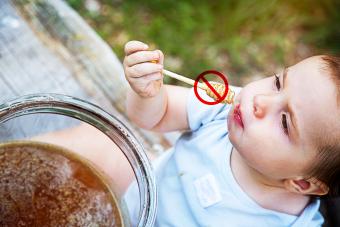
One of the biggest fears new parents have is whether their child is eating enough (or too much). Fortunately, with time comes experience, and with experience, comes confidence. That being said, a bit of understanding about how much your little one should be eating during her first year of life can help you make sure she's getting the nutrients and calories she needs to grow and learn. Keep in mind that the following information is an average with some babies eating less and some more.
The First Six Months
During the first few months after you bring your baby home from the hospital, the only food she needs is breast milk or formula. According to the Mayo Clinic, your baby doesn't need anything else during this time. In fact, her body isn't developed and mature enough to handle anything other than breast milk or formula.
How Much to Feed
Your baby does quite a bit of growing in the first four months. KidsHealth breaks down how much your baby should drink:
- A newborn should be getting one-and-a-half to three ounces of breast milk or formula every two to four hours.
- By two months, that number will increase to as much as five ounces every three to four hours.
- By four months, your baby can take around four to six ounces depending on the frequency of feedings.
- By six months, you can feed your baby about five to six ounces every four to five hours.
This is easy to monitor if you're bottle feeding, but for nursing babies, be sure your little one empties your breasts at each feeding and continues to wet her diapers consistently.
How to Know if Baby Is Getting Enough
- In the beginning you'll need to feed your infant on demand, with the average baby eating eight to twelve times in a 24-hour period.
- Babies who drink breast milk usually eat more often because it digests more quickly than formula.
- La Leche League International says you can count your baby's diapers to see if he's getting enough. Babies should have at least five to six wet diapers per day, and generally have two to five bowel movements every 24-hour period. (Although at around six weeks some babies will have larger, but less frequent bowel movements.)
Six to Eight Months
You are likely to get all kinds of advice when it comes to starting solid foods. The American Academy of Pediatrics suggests that you can introduce solid foods around six months, however, you'll want to discuss this with your pediatrician. Since your baby is starting solids, you should watch his hunger cues to know how much formula or breast milk to feed him.
When to Introduce Solids
Introducing solids can be messy, but it's also fun to see your baby develop new tastes and discover the magic of something besides liquid meals. Of course, at this age, your baby still needs plenty of breast milk or formula to go along with his new meals.
- Can sit pretty well without help
- Holds his head up
- Shows an interest in eating solids
- Tries to grab food from your plate during mealtime
- Turning away from your breast or his bottle when he isn't hungry
How to Introduce Solids
KidsHealth.org cautions parents to introduce only one new food every couple of days so that they can watch for signs of an allergy. Use the following guidelines for introducing solids to your baby:
- Start with one to two tablespoons of infant cereal twice per day. The cereal should be a fairly runny consistency, thinned with breast milk. If your baby doesn't seem interested, take a break and try again tomorrow.
- Continue feeding formula or breast milk. Your baby will take in 28 to 45 ounces per day, but it's important to follow his hunger cues.
Transitioning to a Solid Diet
With this phase comes the opportunity to start sharing family meals with your baby. Once your baby is accepting cereal, you can start giving your baby purees and even some of the foods you eat. In the beginning of this time frame, you'll want to stick to purees, but towards the end of the eight-month mark, you can likely begin giving small bits of finger foods. To help make the transition go more smoothly, Gerber offers a few tips:
- Offer new foods when your baby is well rested and in a good mood.
- Try something new every three days.
- Place the food in a bowl to cue that it's time to eat.
Additional Guidelines
The National Institutes of Health outlines the following guidelines for feeding your baby during this time frame. Remember, though, that each baby is different, so don't feel like these numbers are written in stone. It's important to follow your baby's cues.
- Offer breast milk for formula as your baby wants it, which will gradually be less and less as she fills up on solids.
- Keep offering infant cereal. Your baby will likely eat 3 to 4 tablespoons twice per day.
- Begin offering two to three tablespoons of fruits and vegetables up to four times per day. Start with single fruits and vegetables and work your way toward blends once your baby has tried everything in the mixtures.
- You can offer small amounts of finger foods such as soft-cooked vegetables, melba toast, noodles, peeled fruits or teething biscuits.
Eight to Ten months
Things won't change much in this time frame except that your baby will likely increase the amount he is eating on any given day. He will continue to eat less breast milk or formula and will eat more purees and table foods. The experts at Kids Health suggest offering more foods with a texture that encourages chewing. Make sure the pieces are small enough that your baby isn't at risk of choking. The National Institutes of Health outline the following tips at this age:
- Breast feed or offer a bottle of formula as your baby wants it.
- Continue serving three to four tablespoons of baby cereal twice per day.
- Increase purees to three to four tablespoons three to four times per day.
- Begin offering three to four tablespoons of meat once a day.
- Continue offering two tablespoons to two cups of soft fruits, vegetables, breads and noodles.
- Introduce egg yolks, but hold off on the whites until your baby is a year old, recommends the Child's Health Guide, as the whites are a common allergen.
- Soft cheese, mashed beans and o-shaped cereals are other great options at this age.
10 to 12 months
As your baby nears her first birthday, her eating habits will be dramatically different than they were when she was a newborn. In this short amount of time she will go from a diet of only breast milk or formula to a meal plan that includes pretty much anything you serve the rest of the family. Once she's one your baby can likely begin drinking cow's milk. The Children's Hospital of Philadelphia gives the following guidelines for what your child needs to eat include:
- One-third cup of dairy
- One-fourth to one-half cup fruits
- One-fourth to one-half cup vegetables
- One-half to one cup combo foods like macaroni and cheese or mashed potatoes, casseroles, etc.
- One-fourth to one-third cup protein foods or meats
Follow your baby's cue for breast milk or formula.
Making Mealtime Successful for Your Baby
Feeding your baby is likely to be a source of stress and anxiety from time to time, but once you know all the ins and outs and have a good idea of his appetite and preferences, it will become second nature to you and your little one. The bottom line - enjoy it because it won't last forever and you'll come to miss the bonding that comes with feeding your baby.







